
Remember a target is only a figure to be monitored to see if it is achieved. If it is u only need to check the next dividend announcement to see if u want to to continue to hold. WB states his favourite hold time is forever.
Investment Trust Dividends

Remember a target is only a figure to be monitored to see if it is achieved. If it is u only need to check the next dividend announcement to see if u want to to continue to hold. WB states his favourite hold time is forever.
Royston Wild explains why this 10.1%-yielding FTSE 250 stock might be one of London’s greatest dividend growth shares right now.
Royston Wild

When investing, your capital is at risk. The value of your investments can go down as well as up and you may get back less than you put in
Over time, the London stock market’s proved a happy hunting ground for investors seeking dividend growth shares.
With an average dividend yield of around 3.5%, the FTSE 100 and FTSE 250 indexes provide larger dividends than most overseas bourses. This is thanks in part to the UK market’s long-established culture of paying cash rewards.
It’s also because many British companies are well-established in mature markets. They receive stable cash flows in industries like energy, banking, consumer goods and utilities. These can then be distributed in the form of dividends.
Dividends are never guaranteed, of course. As we saw during the Covid-19 pandemic, even the most dependable dividend growth stock can suddenly reduce or axe payouts entirely.
Buy buying stocks with strong balance sheets, solid positions in defensive markets, and a proven commitment to paying dividends can greatly enhance an investor’s chance of receiving a healthy passive income.
Here’s one I’d buy if I had spare cash to invest. If analyst forecasts are correct, it could provide a £1k second income this year.
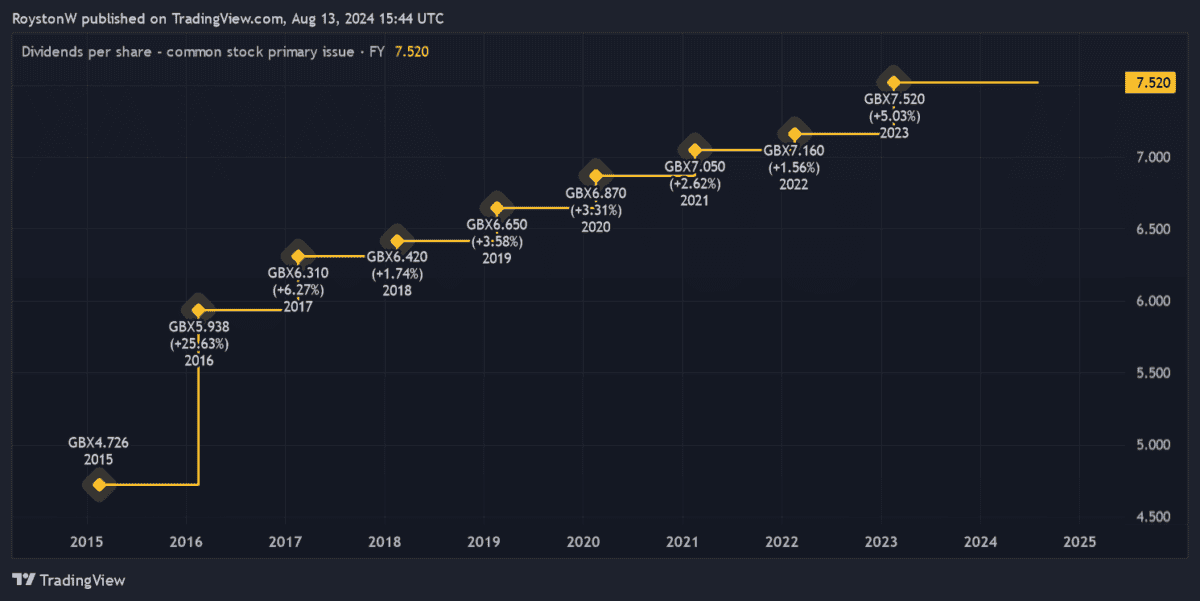
As the chart shows, NextEnergy Solar Fund (LSE:NESF)has a long history of raising the annual dividend. In fact, following its decision to raise fiscal 2024’s total payout to 8.35p per share, it’s increased cash rewards every year since its IPO back in 2014.
Being a renewable energy stock, the company benefits from stable cash flows at all points of the economic cycle. Electricity’s one of life’s essential commodities, so NextEnergy has the financial capacity as well as the confidence to pay a growing dividend.
What’s more, with a large proportion of its regulated revenues linked to the Retail Price Index (RPI), its ability to increase dividends remains strong, even during inflationary periods.
There are risks to buying NextEnergy Solar Fund. Energy generation dropped almost 7% last year, to 852GWh, which the firm attributed to “increased rainfall and humidity (which can affect the performance of certain components)”.
But weather-related issues to this extent are uncommon. Indeed, solar panels are well known for providing a consistent flow of electricity, thanks to average yearly irradiation and limited moving parts. This makes NextEnergy a much more reliable profits generator than many other renewable energy shares.
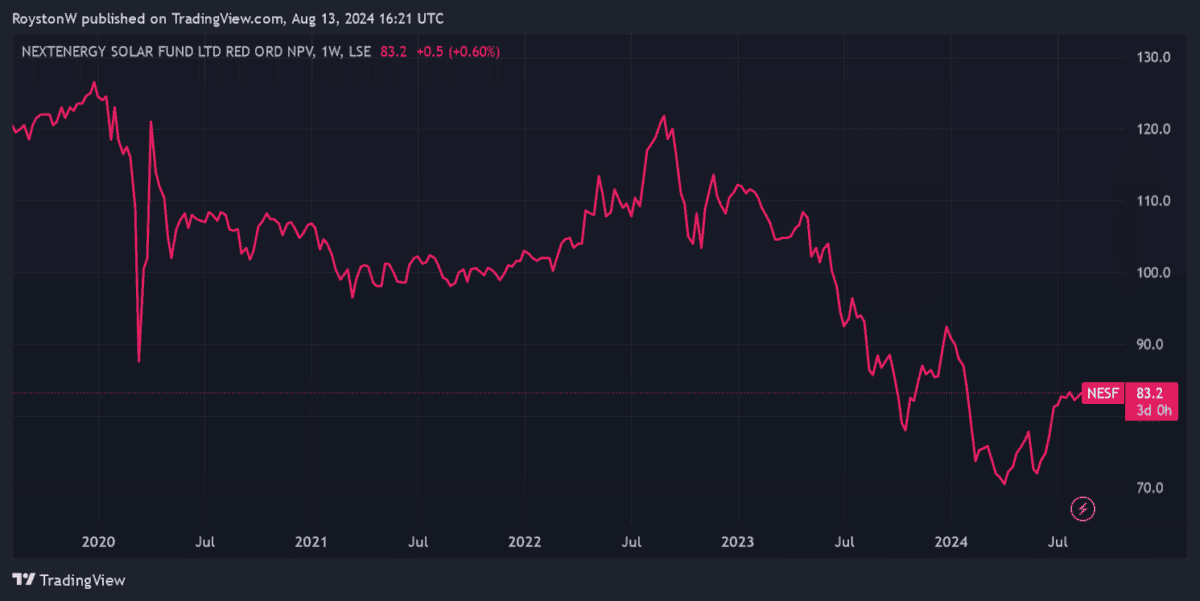
As the chart shows, the company’s share price has struggled more recently. Higher interest rates have squeezed its net asset values (NAVs) and pulled down earnings. This could remain a problem too, if inflationary pressures persist and central banks keep rates around current levels.
Yet the spectacular cheapness of NextEnergy’s share price still makes it worth serious consideration, in my opinion. The firm trades at a 22% discount to its estimated NAV per share of 105.7p.
With its forward dividend yield also sitting at 10.1%, I believe it could be one of the best value income stocks out there and worth considering.
If I invested just over £9,900 in NextEnergy shares, this would give me a juicy £1,000 in passive income this year alone. That’s assuming that broker forecasts are accurate.
$$$$$$$$$$$
As we saw during the Covid-19 pandemic, even the most dependable dividend growth stock can suddenly reduce or axe payouts entirely.
££££££££££
Investment Trusts have reserves they can use to pay their dividends in times of market stress and that is the reason there are only Investment Trusts in the Snowball.

The Telegraph thinks Merchants is well placed to capitalise over the long term, while The Mail on Sunday’s Midas believes Custodian Property Income has shown that it can deliver through thick and thin.

ByFrank Buhagiar•12 Aug, 2024•

The Telegraph’s Questor is upbeat about the FTSE 100’s future prospects. Bargain-basement valuations; globally focused companies (over 80% of sales made by FTSE100 constituents are generated outside the UK); and an improving outlook for the world economy – just three reasons cited for the tipster’s positivity. And Questor is putting its money where its mouth is by increasing its wealth preserver portfolio’s exposure to UK large-cap stocks. It’s doing this by adding a holding in long time favourite Merchants (MRCH). Easy to see why – the UK equity income fund was originally tipped by Questor back in February 2020 and has since generated an 18% capital return. The five-year record is even more impressive – up +50% compared to the FTSE All-Share’s +31%.
MRCH isn’t just a play on the world economy though, but the UK too. In addition to having 54% of its funds invested in FTSE 100 stocks, a further 39% of its holdings herald from the more domestically oriented FTSE 250. A more stable political outlook and the prospect of further interest rate cuts all bode well for UK mid-caps then. A positive global and domestic outlook allows Questor to be comfortable with MRCH’s11% gearing which could prove to be a useful ally in a rising stock market. And then there’s the income side of the equation. For as well as targeting long-term capital returns, the c. £900m fund looks to deliver above-average dividend growth, a neat fit with the wealth preserver portfolio’s aim to generate above-inflation total returns.
So too is MRCH’s strategy which is to buy stocks with sound fundamentals when they trade at attractive valuations. As Questor concludes “With Merchants having an excellent track record of outperformance, a sound strategy and generous gearing, it is well placed to capitalise over the long term.”
Midas: The property investment trust going cheap and packing a 7.5% dividend
The above-titled article opens with an interesting fact: the UK produces over 25 billion pints of milk a year. What that has to do with Custodian Property Income (CREI), the property investment trust that has caught the attention of The Mail on Sunday’s tipster, to be revealed later. But first, Midas highlights how CREI came to market in 2014 with £100 million worth of property and a £1 share price. Fast forward to today and the property fund’s assets are valued at £590 million. The share price has moved in the opposite direction however – the shares trade below the 80p level. Midas believes “The decline seems overdone and should reverse, as sentiment towards the property industry improves and interest rates continue to fall.”
In the meantime, shareholders are being paid to wait. Last year, CREI paid out 5.8p per share in dividends. This year, 6p per share is being targeted. At the current share price that equates to a 7.5%+ yield. Those high payouts are no one-offs. That’s because management “firmly believes that the main purpose of property firms is to generate reliable income for investors.” And because of those high dividend payments, investors who bought shares at the time of the 2014 listing would have made a 36p return on every 100p invested. That easily beats the 20% return generated by other listed property stocks over the same period.
What’s more CREI has achieved this sector-beating return without taking on excessive risk. At the heart of this is the portfolio’s diversification: properties – at the last count there were 155 spread across the country; tenants – the properties are let to more than 300 tenants, meaning no single tenant accounts for more than 1.5% of the rent roll; and sectors – the portfolio is exposed to a wide range of sectors including out-of-town retail parks and small industrial sites. Because of that diversification, “Custodian has shown that it can deliver through thick and thin, dividends are a big draw. At 79p, the stock is a buy.” As for what connects CREIto the 25 billion pints of milk the UK produces each year – Silgan Closures is a leading producer of lids for plastic milk bottles and produces these at an industrial unit owned by CREI.
££££££££££££
MRCH currently yields just under 5%, so if u wanted to buy and maintain a portfolio yield of 7%, u would need to pair trade it with another yielder.
JLEN Environmental Assets (JLEN) and the wider renewable energy infrastructure sector have traded at a persistently wide discount with investor sentiment continuing to wane. This has triggered the activation of a discontinuation vote at JLEN’s AGM in September. We strongly believe shareholders should vote against discontinuation, taking into account the strong long-term track record of the company, which has produced NAV total returns of 119.5% since its launch just over 10 years ago to the end of June and delivered dividend growth every year.
The fundamental growth story for the sector remains as strong as ever, with investment in the energy sector continuing to swell – the majority of which is going to clean energy technology such as renewables, low carbon fuels, nuclear, grids and battery storage.
JLEN aims to provide its shareholders with a sustainable, progressive dividend, paid quarterly, and to preserve the capital value of its portfolio. It invests in a diversified portfolio of environmental infrastructure projects generating predictable wholly or partially index-linked cash flows. Investment in these assets is underpinned by a global commitment to support the transition to a low-carbon economy and mitigate the effects of climate change.
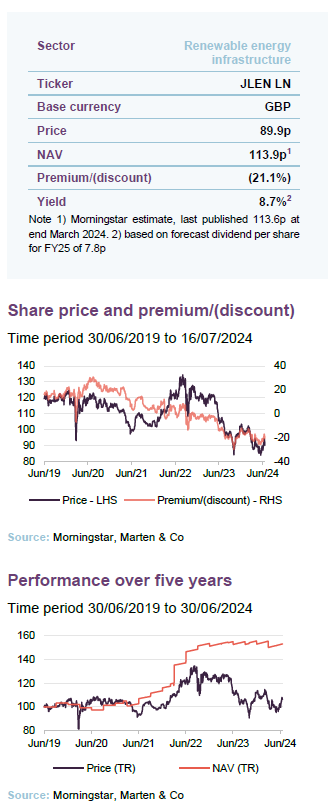
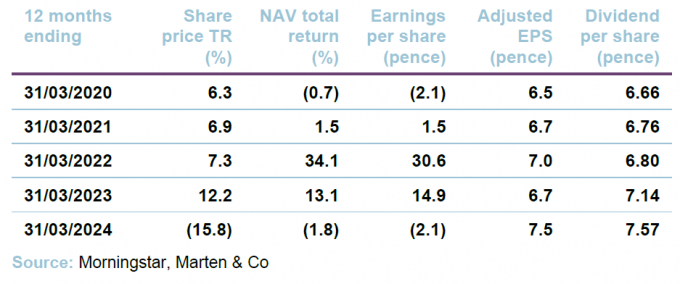
JLEN invests in infrastructure projects that use natural or waste resources or support more environmentally-friendly approaches to economic activity, support the transition to a low carbon economy, or mitigate the effects of climate change.
JLEN’s assets are broadly categorised as intermittent renewable energy generation, baseload renewable energy generation and non-energy-generating assets that have environmental benefits. Intermittent energy generation investments include wind, solar and hydropower. Baseload renewable energy generation investments include biomass technologies, anaerobic digestion and bioenergy generated from waste. Non-energy-generating projects include wastewater, waste processing, low carbon transport, battery storage, hydrogen and sustainable solutions for food production such as agri- and aquaculture projects.
JLEN aims to build a portfolio that is diversified both geographically and by type of asset. This emphasis on diversification reduces the dependency on a single market or set of climatic conditions and helps differentiate JLEN from the majority of its peers, which tend to specialise in solar or wind.
Reflecting its objective of delivering sustainable, progressive dividends and preserving its capital, JLEN does not invest in new or experimental technology. A substantial proportion of its revenues is derived from long-term government subsidies.
JLEN’s AIFM is Foresight Group LLP (Foresight). Foresight is one of the best-resourced investors in renewable infrastructure assets, with £12.1bn of AUM as at 31 March 2024. This includes Foresight Solar Fund, which sits in JLEN’s listed peer group. Foresight has a highly experienced and well-resourced global infrastructure team with 175 infrastructure professionals managing around 4.7GW of energy infrastructure. It is a global business, with offices in eight countries. The co-lead managers to JLEN are Chris Tanner and Edward Mountney.
In annual results announced last month, JLEN reported a total NAV of £751.2m or 113.6p per share at 31 March 2024 – a 7.7% fall over the year. This equated to a NAV total return of -1.6% including dividends of 7.57p (which were 6% up on the prior year). JLEN’s NAV total return since IPO is 115.9% (8.0% annualised).
Cash from projects at record high underpinning the dividend
Distributions received from projects were at a record high of £87.0m (2023: £83.6m) and underpinned the dividend with a coverage of 1.3 times. The value of the portfolio fell £6.6m over the period, as shown in Figure 1, due mainly to changes in power price and discount rate assumptions, offset by underlying growth in the portfolio.
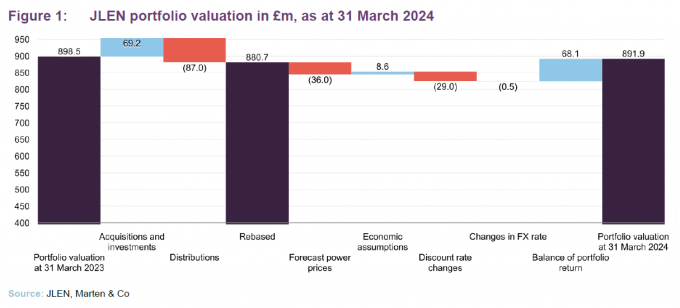
As with many of its renewable energy and infrastructure peers, JLEN’s shares have been trading at a wide discount since interest rates ballooned in 2022. With the discount having averaged more than 10% in the financial year, a discontinuation vote has been triggered, which will take place at the company’s AGM in September.
Somewhat counterintuitively, shareholders should vote against the resolution if they want the company to continue. We believe this is the course investors should take, given the strong long-term track record of the company (see page 15), including delivering dividend growth every year since its launch 10 years ago (see page 19 for the dividend section).
Change in name and cut in management fee proposed
A reduction in the investment management fee will come into effect from 1 October (see page 21 of this note for details), while the board has proposed to shareholders a change in name of the company to Foresight Environmental Infrastructure – to reflect the fact that it has been five years since Foresight acquired the management team of John Laing (which informs the current name). The board states that it has assessed the benefits available through a closer association with the investment manager – including the scale afforded by its broader marketing initiatives and strong market reputation – and believes that there are clear commercial benefits to renaming the company. Should shareholders approve the proposed change of name, the board is recommending the company’s ticker change to FGEN and its website address switch to FGEN.com.
The timing and pace of the impending interest rate cutting cycle is unknown, but the general consensus seems to be that the first rate cut in the UK will come in August – despite inflation falling back to the Bank of England’s target 2% in May. The first downward move in the base rate will be an important moment for many sectors, not least renewable energy infrastructure, where the higher interest rate landscape has put a substantial downward pressure on NAVs and, even more so, investor sentiment.
A general acceptance that the eventual pace of cuts is likely to be slower than first thought, plus the impact of falling inflation on cash flows from energy-generating assets and continued geopolitical instability, has seen discounts across all infrastructure companies remain persistently wide.
Estimated $2.8trn invested in energy sector in 2023, the majority of which aimed at clean energy technology
However, the fundamental growth story for the renewable energy infrastructure sector and JLEN remains as strong as ever, with the green agenda an urgent priority of most global governments. The International Energy Agency (IEA) has estimated that investment in the energy sector amounted to $2.8trn in 2023, of which more than 60% was invested in clean energy technology such as renewables, low carbon fuels, nuclear, grids and battery storage.
There seems to be political support across the benches for boosting clean energy capabilities in the UK and in Europe (key markets for JLEN), despite the recent European Union elections. The new Labour government in the UK has pledged to ‘make Britain a clean energy superpower’ and has vowed to work with the private sector to double onshore wind, triple solar power, and quadruple offshore wind by 2030, while also investing in carbon capture and storage, hydrogen and marine energy to ensure the country has the long-term energy storage it needs. This is in contrast to the US, where a Trump administration seems likely to scrap the Inflation Reduction Act (IRA, which has worked well in incentivising investment in green technology).
JLEN’s diversified portfolio and the manager’s strong track record and expertise in the sector seems completely at odds with its current discount of 21.1%. JLEN’s board has set out its approach to capital allocation, which includes prudent management of debt and consideration of share buybacks if they are NAV accretive. We explore the factors impacting JLEN’s NAV in detail below, beginning with power prices.
Despite having already fallen steeply from highs seen in 2022, electricity prices continued to fall further and faster than anticipated over the last year, as shown in Figure 2.
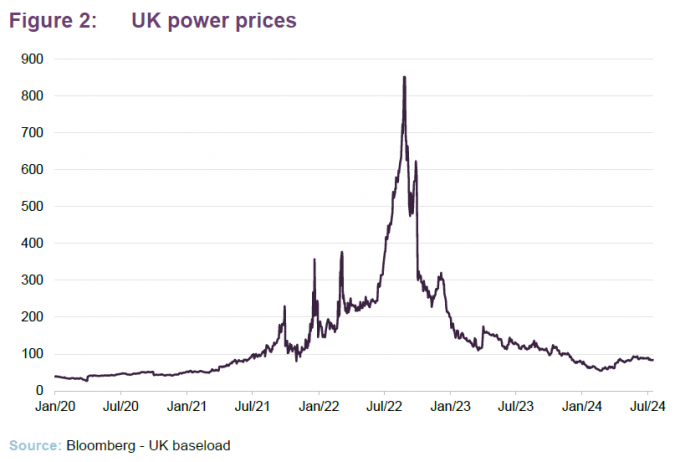
The overall change in forecasts for future electricity and gas prices compared to forecasts at 31 March 2023 negatively impacted JLEN’s NAV by £36.0m or 5.4p in the year to the end of March 2024.
Fixed prices secured on the majority of portfolio
JLEN looks to de-risk its exposure to volatile market prices and has fixed prices for the majority of its output. At 31 March 2024, the portfolio had price fixes secured over 61% for the Summer 2024 season and 58% for Winter 2024/25 season. Short-term market forward prices for the next two years are used to value the portfolio where contractual fixed price arrangements do not exist. After the initial two-year period, the project cash flows assume future electricity and gas prices in line with a blended curve informed by the central forecasts from three established market consultants.
Based on the portfolio at end March 2024, a 10% fall in power prices over the remaining life of JLEN’s assets would take off £37.4m or 5.7p from the NAV and a 10% increase would add £37.0m or 5.6p to the NAV. Even though the last months of the previous year had already seen electricity prices fall sharply from the highs seen during the energy crisis in 2022, electricity prices continued to fall further and faster than anticipated. In the year to March 2024, power prices reduced by a further £40/MWh – equivalent to approximately 40%.
JLEN’s manager states that in the extreme event that electricity prices fall to only £40/MWh, the company would maintain a resilient dividend cover for the next three financial years.
Gilt yields have remained at an elevated level for almost two years, as shown in Figure 3. Government borrowing costs rose sharply from the beginning of 2021 and accelerated in the fallout from the ‘mini budget’ of September 2022 and have remained elevated since.

The weighted average discount rate now sits at 9.4%
JLEN’s weighted average discount rate has remained unchanged over the six months to 31 March 2024 at 9.4%. This is 100bps higher than a year prior due to an upward movement in the discount rate applied in June and September 2023, reflecting the sustained increase in UK gilt yields as well as continued investment into JLEN’s ongoing development and construction projects (which are valued using higher discount rates to reflect the development risk). However, the discount rate was reduced on some construction projects that achieved key milestones during the year.
The overall uplift in discount rate over the year took £29.0m off the NAV.
The discount rates that are used in the discounted cash flow calculations that inform the NAVs of many alternative assets funds, including those in the renewable energy sector, can be broken down into the risk-free rate – derived from the yield on a government bond with equivalent duration – plus a risk premium. The risk premium element of the discount rates calculation is influenced by various factors including the composition of the portfolio and investors’ risk appetite for these sectors and projects, based on recent comparable market transactions.
An independent verification exercise of the methodology and assumptions applied in JLEN’s NAV calculation is performed by a leading accountancy firm and an opinion provided to the directors on a semi-annual basis.
Inflation assumptions upgraded slightly
62% of JLEN’s forecasted revenues are contractually linked to inflation (as measured by the RPI) through government-backed subsidies and long-term contracts. An uplift in inflation assumptions used to value JLEN’s portfolio (based on actual data and independent forecasts) to 3.5% RPI inflation for 2024 (from an assumption of 3.0% at 31 March 2023) – reverting to 3% until 2030, and then falling to 2.25% thereafter – resulted in an overall increase in value of £8.6m.
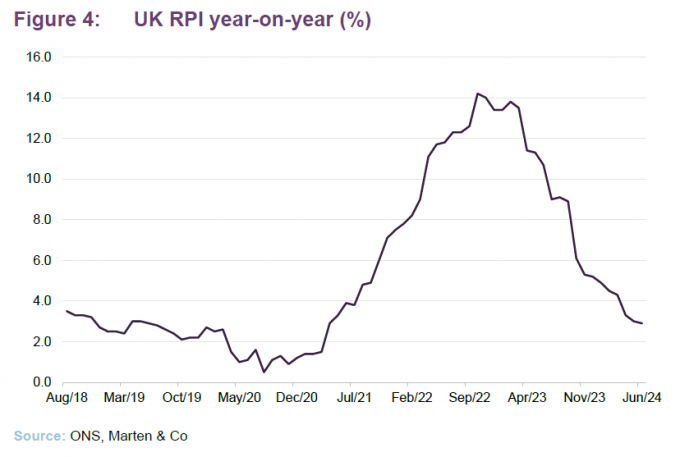
Figure 4 shows that RPI inflation fell to 2.9% in June 2024. JLEN’s sensitivity to changes in the inflation rate is about +£19.3m or 2.9p on the NAV for every 0.5% increase in the forecast inflation rate and a decrease of £18.9m or 2.9p on the NAV if rates were reduced by the same amount.
The assumption JLEN uses for the useful economic life of investments is the lower of lease duration and 35 years for solar assets, 30 years for wind farms and 20 years for anaerobic digestion (AD) facilities – being the life of the RHI subsidy. JLEN applies a conservative valuation in regard to its AD assets, with the assumption that the facilities will simply cease to operate beyond the life of their RHI tariff. The manager says that it has seen a growing case of evidence, including several transactional datapoints, pointing towards a positive change in market sentiment for valuing these assets – including the potential to run anaerobic digestion facilities on an unsubsidised basis.
In light of this change, the manager has provided a sensitivity extending the useful economic lives of its AD portfolio by up to five years – capped at the duration of land rights already in place. Such an extension would result in an uplift in the portfolio valuation of £21.9m or 3.3p.
As we discussed in more detail in previous notes (links to which can be found on page 24), the UK government introduced a temporary windfall tax on electricity generators – the Electricity Generator Levy (EGL) – in response to higher energy prices. JLEN’s wind, solar and biomass assets are affected by the levy, which saw the government take 45% of revenues above a price of £75/MWh from 2023 to April 2024, and thereafter adjusted each year in line with inflation (as measured by CPI) on a calendar-year basis until the levy comes to an end on 31 March 2028. JLEN paid £5.5m on the EGL tax in the financial year, with the annual liability for the 2025 financial year estimated to be lower, reflecting the drop in power price forecasts year-on-year.
Around 42% of JLEN’s assets at the end of September 2023 fell completely outside of the levy. The managers say that this is a strength of having a diversified portfolio that has a combination of assets that generate electricity (and fall in the scope of the levy), assets that generate gas (the anaerobic digestion plants), and assets that do not generate energy at all (batteries, CNG refuelling stations, and the controlled environment assets).

Stick to your plan until it sticks to you.
Thursday 15 August
Alternative Income REIT PLC ex-dividend payment date
Aquila European Renewables PLC ex-dividend payment date
Baillie Gifford UK Growth Trust PLC ex-dividend payment date
Balanced Commercial Property Trust Ltd ex-dividend payment date
BlackRock Sustainable American Income Trust PLC ex-dividend payment date
Fair Oaks Income Ltd ex-dividend payment date
Greencoat UK Wind PLC ex-dividend payment date
Henderson Opportunities Trust PLC ex-dividend payment date
ICG Enterprise Trust PLC ex-dividend payment date
Impax Environmental Markets PLC ex-dividend payment date
Majedie Investments PLC ex-dividend payment date
Montanaro European Smaller Cos Trust PLC ex-dividend payment date
Murray Income Trust PLC ex-dividend payment date
NextEnergy Solar Fund Ltd ex-dividend payment date
Octopus Renewables Infrastructure Trust PLC ex-dividend payment date
Pershing Square Holdings Ltd ex-dividend payment date
Reach PLC ex-dividend payment date
Renewables Infrastructure Group Ltd ex-dividend payment date
Target Healthcare REIT PLC ex-dividend payment date
Tritax EuroBox PLC GBP ex-dividend payment date
VH Global Sustainable Energy Opportunities PLC ex-dividend payment date
| https://www.chestersasia.com/ chestersasia.com xiomarasanmiguel@aol.com 78.46.108.24 | Hi, i think that I saw you visited my web site thus I came to go back the desire? I am attempting in finding things to enhance my web site! I assume its good enough to use some of your concepts!! |
Yep.

I’ve bought for the portfolio 7303 shares in BSIF for 8k, yielding 8% ahead of the next dividend.
Cash to re-invest £348.35
| Best performing funds in price terms | % |
|---|---|
| Tritax EuroBox | 13.3 |
| Balanced Commercial Property Trust | 10.5 |
| TR Property | 10.4 |
| AEW UK REIT | 9.9 |
| Shaftesbury Capital | 9.9 |
| Picton Property | 9.4 |
| Schroder REIT | 9.1 |
| Tritax Big Box REIT | 8.9 |
| Capital & Regional | 8.3 |
| Unite Group | 7.9 |
Source: Bloomberg, Marten & Co
| Worst performing funds in price terms | % |
|---|---|
| Regional REIT | (18.1) |
| Real Estate Investors | (8.1) |
| Conygar Investment Company | (7.2) |
| Grit Real Estate Income Group | (5.6) |
| Helical | (5.1) |
| Macau Property Opportunities | (3.3) |
| Palace Capital | (1.7) |
| IWG | (0.9) |
| Ground Rents Income Fund | 0.0 |
| Ceiba Investments | 0.0 |
Source: Bloomberg, Marten & Co
It already feels a long time ago that Labour won a landslide election at the start of July, but this seems to have had a calming influence on the market. The long-awaited interest rate cut occurred at the start of August, but even before this, the average share price move amongst the listed property sector was +3.1%. Corporate activity was again the driver behind many of the largest share price gains, with European logistics landlord Tritax EuroBox revealing that it was in discussions with more potential suitors following initial interest from Brookfield. A conclusion to Balanced Commercial Property Trust’s strategic review seems to be close, with a bid still on the cards. European property securities trust TR Property posted a double-digit uplift in its share price, mirroring the performance of its portfolio companies during the month. Values were back trending upwards for many of the diversified REITs, with AEW UK REIT (which also reported progress on dividend cover), Schroder REIT and Picton Property all seeing impressive share price gains. Capital & Regional continues to be the subject of takeover discussions, with a second party entering the fray. Meanwhile, student specialist Unite Group raised £450m in a placing.
Worst performing funds
Office landlord Regional REIT saw another sizable drop in its share price following a dilutive £110.5m rights issue in June. The company now languishes on a monstrous discount to NAV of almost 80%. Real Estate Investors is in wind down mode and reduced its dividend to reflect lower earnings from its diminishing portfolio. Three other companies at various stages of winding up – Macau Property Opportunities, Palace Capital and Ground Rents Income Fund – also feature. The residual value of the latter’s portfolio continues to be negatively impacted by leasehold reforms, but in a much more buoyant environment, a flat NAV was enough to earn its and Cuban property investor Ceiba Investments’ places in the table. Many other thinly traded real estate companies also made the worst performing funds table in July, reflecting the volatile nature of their share prices. This was the case for UK investor/developer Conygar Investment Company, and pan-African real estate investor and developer Grit Real Estate Income Group. Having staged a mini share price revival in the wake of its strategic review, in which it vowed to continue in its pursuit of development returns, London office developer Helical gave up those gains and now trades on a circa 35% discount to NAV.

| Company | Sector | NAV move (%) | Period | Comments |
|---|---|---|---|---|
| AEW UK REIT | Diversified | 3.1 | Quarter to 30 June 24 | 2.4% like-for-like valuation increase for the quarter to £215.8m |
| Schroder REIT | Diversified | 0.5 | Quarter to 30 June 24 | Portfolio value increased 0.3% to £461.6m |
| Picton Property | Diversified | (0.1) | Quarter to 30 June 24 | Like-for-like portfolio valuation increase of 0.4% to £700.2m |
| Balanced Commercial Property Trust | Diversified | (2.1) | Quarter to 30 June 24 | Value of portfolio fell 1.5% to £943.3m |
| Unite Group | Student accom. | 5.3 | Half-year to 30 June 24 | Portfolio valued at £5.7bn, up 2.7% on a like-for-like basis |
| Shaftesbury Capital | Retail | 1.6 | Half-year to 30 June 24 | Portfolio valuation increased by 1.4% on a like-for-like basis to £4.8bn |
| SEGRO | Logistics | (1.8) | Half-year to 30 June 24 | Values were flat; however, NAV fall was largely due to the impact of an equity placing |
| Primary Health Properties | Healthcare | (2.8) | Half-year to 30 June 24 | Value of portfolio declined 1.4% to £2.75bn |
| Hammerson | Retail | (25.5) | Half-year to 30 June 24 | NAV hit by sale of Value Retail stake at 24% discount to book value (see page 4 for details) |
Source: Marten & Co
© 2025 Passive Income Live
Theme by Anders Noren — Up ↑